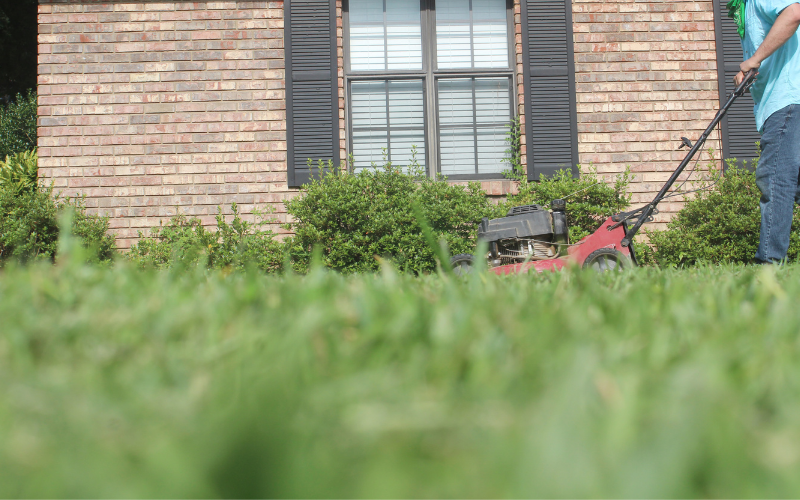Have you been contemplating a switch from one type of mower blade to another? Maybe you’ve been using standard blades, but you’ve heard good things about mulching blades and you’re intrigued.
Mulching is a great way to naturally feed your lawn – but is there anything else you should know about before you make the change?!
I’m going to compare mulching blades and regular blades in this post, talking about some of the pros/cons/things to expect from each blade, as well as run through the best conditions for each type of blade.

An Overview of Mulching Blades
You might also hear mulching blades referred to a “3-in-1” blades, because you’re able to handle clippings in 3 ways with one fitted; you can bag them, discharge them or mulch them. And it’s obviously that last one that their design is specifically adapted for.
Many people ask if mulching blades can be installed on any mower? The answer is “nearly”. Most modern mowers can accommodate a mulching blade, but not every one will.
So you’ll need to research your specific mower model or reach out to the manufacturer and ask.
Introducing Regular Blades
Regular blades are the “less cool” younger sibling. They’re “only” 2-in-1. They’ve got you covered for bagging and discharging your clippings, but they can’t mulch for s***!
“Lift” is a term you’ll see commonly associated with this type of blade, as their design is geared towards creating a vacuum in the deck to make the grass stand up straight and is then discharged quickly once cut.
Mulching Blades vs Regular Blades: How Do They Differ?
Most mowers will come with a regular blade fitted as standard, unless you went out and bought a mulching mower. Let’s discuss how mulching blades and regular blades differ.
The Shape of the Blade
This is one of the first big differences you’ll notice if you compare mulching blades vs regular blades.
On a regular blade, the cutting edge is practically straight. The design is very aerodynamic and is effective in quickly cutting the grass and then removing it from the deck.
It’s almost the opposite with mulching blades. The blade edge is much more curved, making the surface area of the blade much greater.
The purpose of a mulching blade isn’t to cut and get the clippings out as quickly as possible. They are designed to create greater circulation in the deck to put clippings through the cutting cycle several times to ensure that they finish up as mulch (very fine clippings).
The Length of the Cutting Edge
The other noticeable difference you’ll see when you look at mulching blades vs regular blades is the length of the cutting edge.
Not only do the curves on a mulching blade increase its surface area, but the cutting edge is typically longer too.
Again, this increases the amount of contact the sharp part of the blade has with clippings so that it is able to mulch them.
A regular blade doesn’t need such a long cutting edge as the objective is to cut and discharge the clippings much more quickly.
Pros of Mulching Blades
Now you know what mulching blades are and how they are different vs regular blades, let’s quickly run through some of the main benefits of fitting your mower with a mulching blade.
3-in-1 Functionality
As we’ve already touched on, mulching blades are capable of mulching, bagging and discharging clippings, meaning you have a lot of versatility in a single blade.
Produces Natural Fertilizer
I won’t go into great depth on the advantages of mulching, but obviously a mulching blade is designed to produce this natural fertilizer, and is the only type of blade that can do so.
When done right, mulching can greatly benefit the health of your lawn.
Environmentally Friendly Option
Any time you can get the job done and do right by the environment, it’s a great option, and that’s exactly what mulching blades offer. No more sending clippings to landfill!
Cons of Mulching Blades
Like everything, mulching blades are not without their drawbacks. Here are a few things to be aware of:
Reduced Lift
The design of a mulching blade is geared towards providing the ability to mulch. While you gain a greater cutting surface area and the airflow to circulate the clippings around the deck multiple times, you lose in terms of lift.
As a result, mulching blades are not as effective at bagging or discharging the clippings vs regular blades.
However, providing you keep your grass well maintained, they’ll do a good enough job for most.
More Frequent Mowing Required
If you consider yourself to be a bit lazy like me or you hate mowing your lawn, this probably won’t be good news.
In peak growth periods you’ll likely need to mow twice a week, because mulching blades will often experience clogging if used on longer grass.
Pros of Regular Blades
Now let’s do the same thing for regular blades. Here are a few of the main plus points of using one:
Generate Good Lift
The main thing that a regular blade can do better than a mulching blade is in generating lift.
Regular blades typically provide “medium lift” (it’s possible to buy high lift blades if you need more), and this is the reason why they’re considered the better option if you’re going to bag your clippings every time.
Not as Prone to Clogging
As regular blades generate more lift, they can discharge clippings from the deck more effectively, which reduces the likelihood of clogging.
This means they’re typically a bit more forgiving should you miss one or two mowing sessions (it happens!) and the grass grows a little longer than it should.
A More Level Cut (If Cutting Schedule is Irregular)
I wouldn’t say they produce a more level cut all the time, because if you mow regularly with a mulching blade, you can definitely achieve a very level cut. BUT, as with the point above, I think regular blades are a bit more forgiving if you happen to let your grass overgrow a bit.
This is because the greater lift they generate creates a vacuum effect under the deck, helping the grass to stand up straight when it’s being cut, hence why it ends up being more level.
Mulching blades don’t do such a good job of creating that suction.
Cons of Regular Blades
And now onto the shortcomings. Nothing is ever perfect, right?!
You Can’t Mulch Clippings
Well duh! I know that’s what you’re probably thinking, but it’s true. This is probably the biggest drawback of opting for a regular blade in this comparison.
You won’t be able to mulch your clippings, period.
Not Great For Dusty/Sandy Conditions
The vacuum that a regular blade generates is great for getting a level cut, but if your lawn has fairly sandy soil, it’s also going to suck that up into the deck, which can really accelerate the wear and tear on your mower.
Not only will the blade dull more quickly, but over time it could create holes in your deck too.
Mulching Blades vs Regular Blades: The Bottom Line
Mulching blades vs regular blades. Most people are looking for a winner, but the truth is that neither one of these blades is “better” than the other. They’re designed for different uses.
If you want to mulch your clippings, use a mulching blade. Just don’t let your lawn get too overgrown. Manage to do that and it’ll do an adequate job of bagging and discharging too.
But if you’ve got no interest in mulching and want to bag or discharge your clippings every time, go with a regular blade.


I have a mulching lawn mower and my neighbor is trying to say that my lawn mower threw a rock 8 feet into the air and put a hole in their house
Woah! Sorry to hear that, Rhonda.
I’m no J.D. but I can’t imagine you’re going to have a hard time defending yourself in this case. Launching a rock 8 feet high with a mulching lawn mower would be tricky, and punching a hole through vinyl siding (or whatever their house has) seems unlikely.
If you ask me, it must’ve been the neighbor kid playing baseball with pebbles and a big stick again.
Tom.
I was mowing my lawn and a small stone broke the door panel in my nice new conservatory, and from some 10meters away. My mower has a side discharge so I now watch this very closely when mowing. And not too short if stones are a problem. In my case, moles were the problem moving stones to the surface.
Hi John,
I’ve broken a few windows in my time with either my weed whacker or my lawn mower. Not a nice feeling. This is why I stay away from ever using a lawn mower with an open chute, and I always keep the guard on my weed whacker. Hopefully, you don’t hit any more rocks.
Thanks for the comment.
Tom.
On an acre that has had no care for 20 years and has been taken over by wild grape vines, would it need tilling or cultivating first before laying sod?
Hi Aileen,
Well, the wild grape (Amur Peppervine) can propagate in a number of ways, including seed, cuttings, and root regrowth, so cultivating and tilling will more than likely lead to future regrowth in the future. This is because just by leaving the tap root (main center root) in the ground, the plant will regrow. The last thing you want is wild grape shoots popping up through your new sod.
Wild grape in many states is classified as invasive and needs killing with a specific herbicide or pulling the vines out, making sure that tap root is removed. If you are employing a contractor to lay the new sod, then I’d recommend talking to them to see if they provide this service. Alternatively, you could talk to your local pest control service to see what they can do.
I hope this helps.
Cheers, Tom.
My kikuyu lawn was established using instant lawn squares. My lawn has become very thick. Can I use a mulching blade to reduce the thickness of my lawn to my desired thickness? I always used to use a Scarify Blade is that the same thing?
Hi Phillip,
Scarify blades seem to be the popular choice that most people use to keep Kikuyu grass under control. A mulching blade will not cut the grass any differently; they will just finely chop the grass once it’s up in the deck so that once the grass falls back to the ground, it can easily work its way back into the soil.
Being that you want to reduce the thickness, a mulching blade isn’t going to help. I’d suggest cutting the lawn more often with a scarify blade and working the height down. Just try not to cut too much off in one go. Kikuyu is tough, but cutting off more than a third could cause too much shock and you’ll be filling dead gaps with seed.
Hope this helps 🙂
Tom
We have bumps in our lawn, two inch spots, do they come from night crawlers?
Hi Leo,
If you have small mounds of dirt that look like they have been squeezed out of a tube of toothpaste, then you probably do have nightcrawlers or some other type of earthworm. These little mounds or bumps are called casts or casting. On the plus side, earthworms are great for aeration and allow water and nutrients to penetrate further into the ground.
I hope this answers your question.
Thanks for your comment,
Tom.
Masterly article Tom. Just the information I was looking for. Would be great if you could include some pictures of a few sample blades showing the differences in shape. I just saw in comments someone mention “scarifying blades” I can admit to being terrified at times, but what is this scary-fying in a mowing context?
My (ZT) mower came with mulching blades and what they called a “mulching deck”. I don’t understand what differences there could (or should) be in a deck itself.
I now want to start using a catcher. The mulching blades certainly throw to the side when the side chute is opened, but once a catcher is on the clippings will need some force behind them to carry them back to the rear mounted catcher. Any idea how much more efficient for doing that throwing blades are than mulching blades? I don’t mind changing blades if I have to, but changing the entire deck is a bridge too far.
Hi Egon,
Scarifying means different things in different parts of the world. Here in the States, it’s really another word people use to describe dethatching, but really it’s more aggressive than that. If you ask an Australian what scarifying is, they will probably describe what you would know scalping to be, a very low cut made on a lawn used at certain times of the year to remove the top section of the lawn for improved growth.
A mulching setup consists of two parts, a mulching blade, and a mulching deck. The deck element is a shroud inside the deck that keeps the clipping inside the deck and keeps the clipping in contact with the blade longer. If you google “lawn mower mulching kit,” you’ll see what I mean by a shroud.
As for a bagger for your ZT, it really comes down to what your lawn mower will accept. Some decks have a spare spindle (or option to have) that connects to the deck to power the bagger chute, and some have nothing and just rely on the airflow created by the blade. I would say the ones which connect to the spindle with a belt would be a good idea, but those that don’t, well, supposedly, they ain’t that great. I think I would head the towable route instead.
Here’s an article I wrote on this very subject.
https://lawnmowerguru.com/can-you-put-a-bagger-on-a-zero-turn-mower/
Thanks for the questions.
Tom.